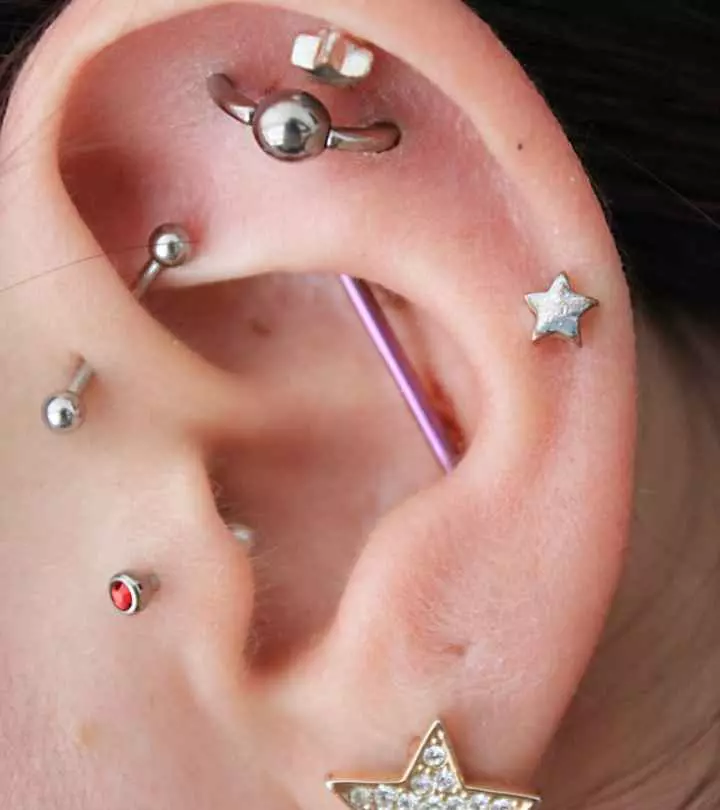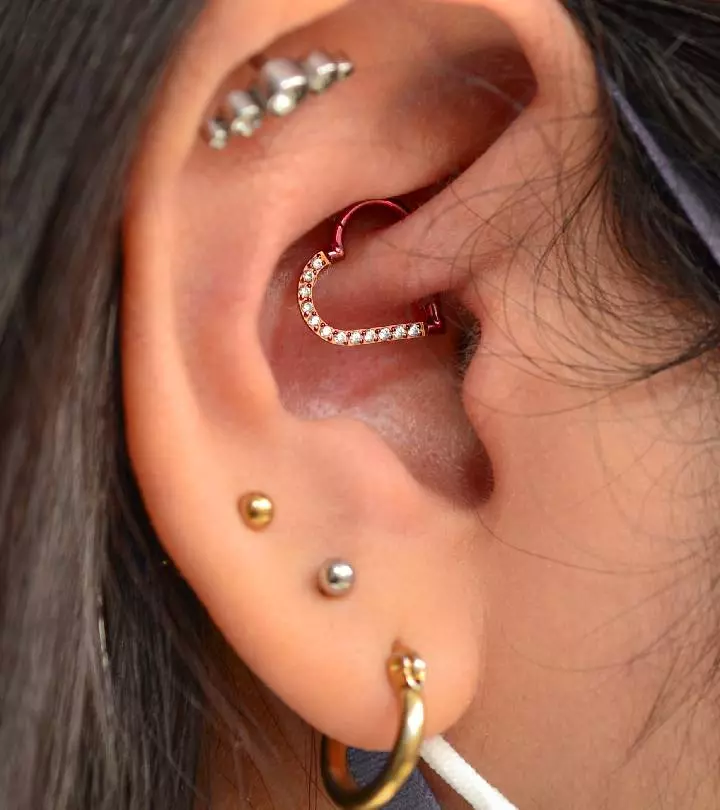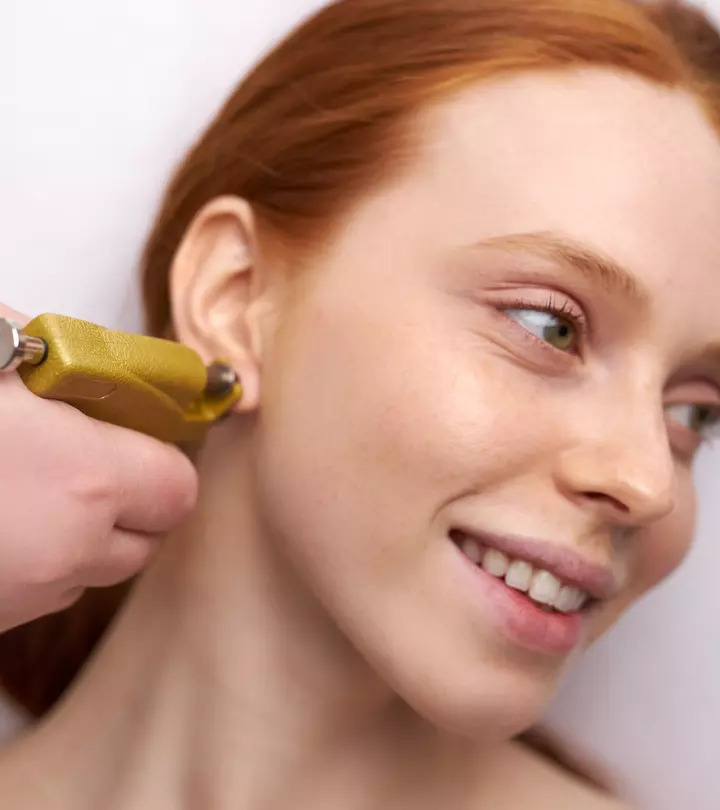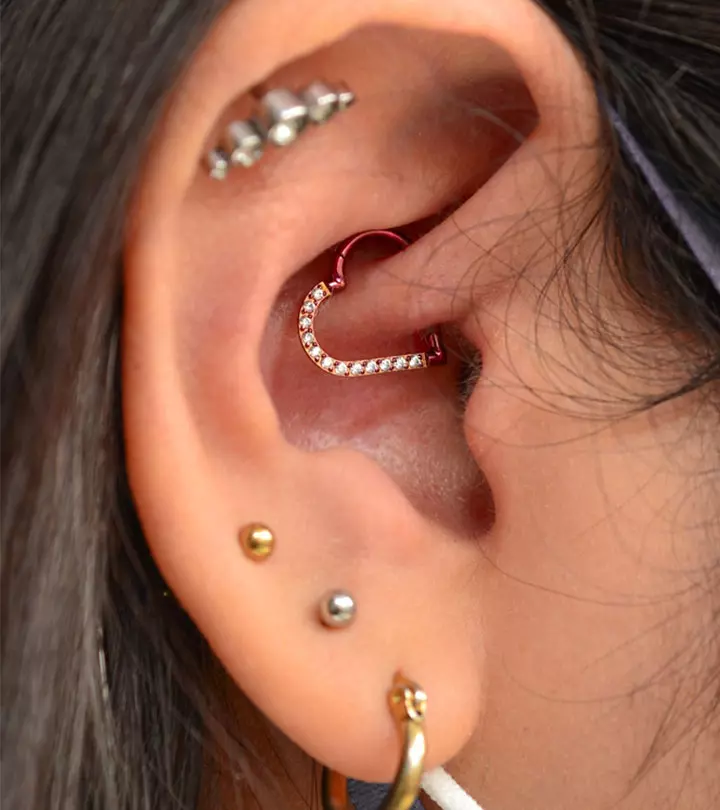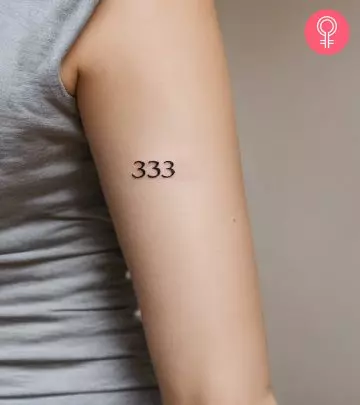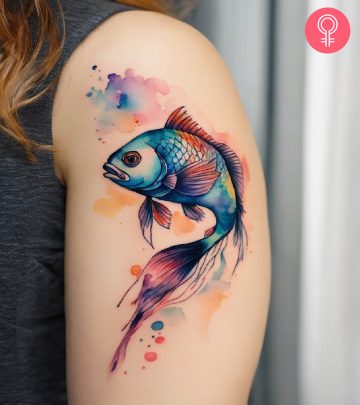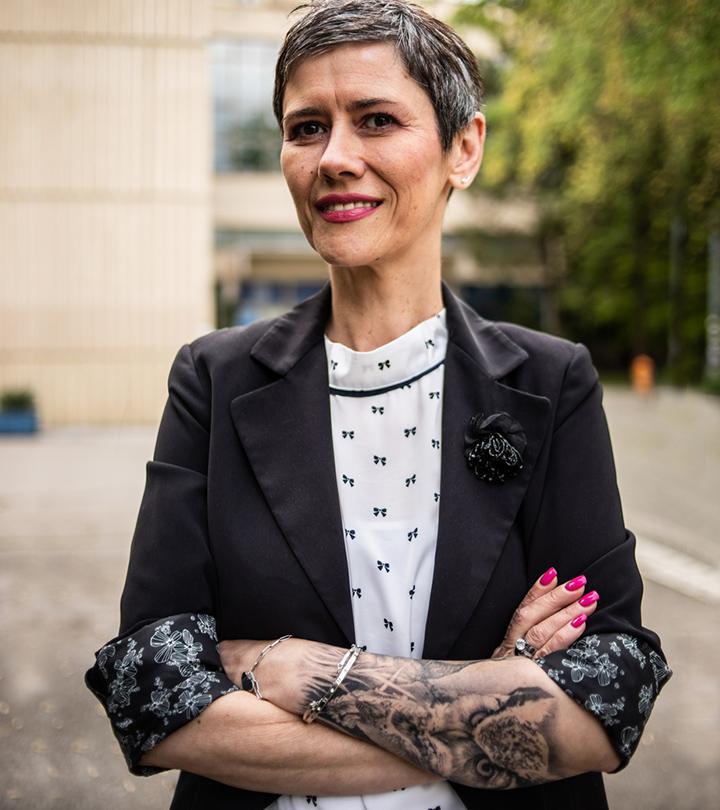Worst And Best Metals For Piercings: A Safe Piercing Guide
Elevate your piercing experience with the finest metal crafted to perfection.
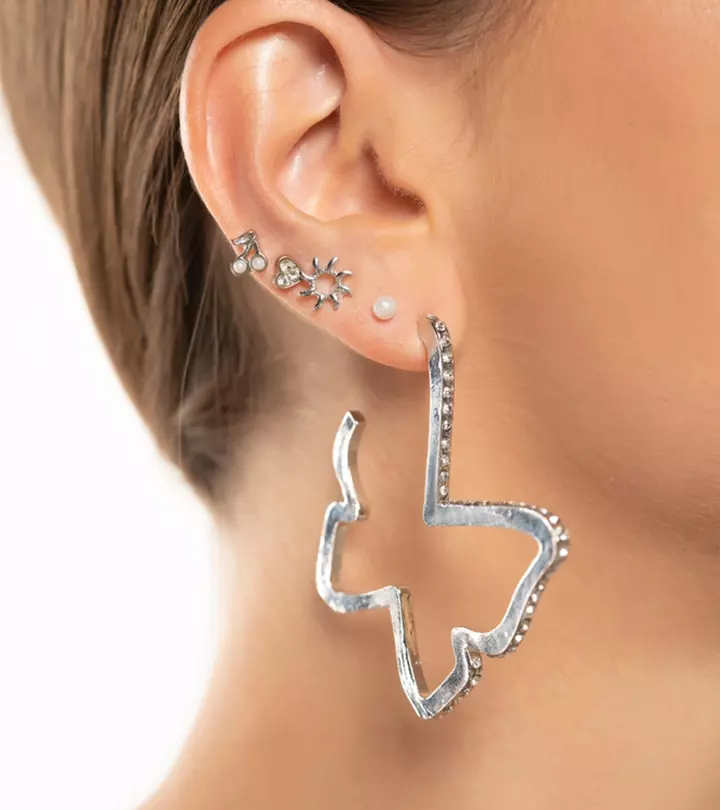
Image: Shutterstock
Piercings enhance a person’s features and help express their unique style. These adornments become treasured accessories, whether it’s a simple nose stud that adds a hint of sparkle or a complex ear constellation that conveys an air of artistry. However, picking the best metal for piercings is important to ensure proper healing and reduce the risk of infection. Choosing metal piercings made from low-quality material, based on impulsive choices or inexperienced piercers, may also cause allergic reactions and lead to health complications and discomfort. In this article, we discuss the best metal options for piercings and the materials you should avoid. Read on!
In This Article
Best Metals For Piercings
The ideal metal for piercings varies depending on several factors, such as the piercing’s location, the length of time it takes to heal, and the sensitivity level of the individual. In general, jewelry can be crafted from a variety of metals. But, when it comes to jewelry for piercings, you need to make sure that the piece you select for your new piercing is made of the best material available, one that is long-lasting, hypoallergenic, and safe for the body. Choosing the wrong metal for a new piercing can cause a lot of problems, including poor healing and an increased risk of infection, even with the best aftercare routine. Here are some of the best piercing jewelry materials (1):
- Surgical Stainless Steel (SSS)
View this post on Instagram
Surgical-grade stainless steel is one of the most common and safe materials suitable for open wounds like fresh piercings. Also, it is particularly durable and affordable, ideal for first piercings. It is crucial to make sure that the stainless steel has a low carbon content and does not release trapped alloys to avoid allergic reactions and skin irritation. Additionally, this metal does not react with bodily fluids, minimizing the risk of infections.
Choose a 316L or 316LVM stainless steel for your piercing since they are less prone to trigger allergies and more suitable for the human body. Even though stainless steel is relatively hypoallergenic, it does contain metals like nickel that can irritate the pierced skin and interfere with the healing process.
- Titanium
View this post on Instagram
For new piercings, implant-grade titanium is a highly recommended metal. Titanium is lightweight and renowned for its hypoallergenic and biocompatible properties, making it a great option for first piercings. Since it contains very little nickel, people with sensitive skin or an allergy to metals can use it.
This metal’s resistance and strength and its ability to withstand corrosion ensures durability even in challenging conditions. As a result, titanium becomes the material of choice for those who want their piercing to be both safe and comfortable.
Tarila, a blogger, shares her experience with using titanium piercing jewelry in her personal blog. She writes, “My nose ring was titanium which is the safest metal for body jewelry and best for people with sensitive skin. Surgical steel also wasn’t a good option for me as I live up north where it gets really cold during the winters and surgical steel gets really cold (i).”
- Niobium
View this post on Instagram
Niobium emerges as a higher-quality alternative to titanium for body jewelry with nearly equal qualities. It can be used for any piercing since it has the same properties as titanium, including color manipulation and non-reactivity with the body.
Niobium is hypoallergenic and suitable for people with sensitive skin or allergies, becoming increasingly popular for body piercings. Its softness, malleability, and low toxicity add to its appeal. Moreover, niobium requires less maintenance, especially for fresh piercings, because of its resistance to oxygen, body fluids, and cleaning agents. Thus, it is a great choice for people allergic to metals and looking for something high-grade and little maintenance.
- 14k/18k Gold
View this post on Instagram
Gold is one of the best metals for body piercings because of its superior quality. When choosing body jewelry, higher-grade gold is preferable because it is purer and comprises fewer alloys. Opt for jewelry made with 14k to 18k gold since it is of the highest quality. Using at least 14k gold is recommended for healing piercings as it contains fewer metals and lowers the possibility of allergic responses.
Gold, like titanium, is safe for the body and resists tarnishing. Though 18k gold can also be used for body piercings, 14k gold is mostly recommended due to its longevity. Those who are sensitive to other metals should ensure that the gold used is of good quality, not gold-plated or gold-filled, and nickel-free to reduce the risk of allergic reactions.
 Pro Tip
Pro Tip- Platinum
View this post on Instagram
Although platinum is uncommon in body jewelry, it is the most costly yet perfect material for long-term body piercings. It is a great option for individuals looking for long-lasting wear because of its remarkable durability and low maintenance needs.
Platinum exhibits superior purity when set against gold and other precious metals, guaranteeing authenticity. Its hardness, similar to that of stainless steel, adds to its durability and toughness. Platinum is the material of choice for everyday body piercing wear because of its hypoallergenic qualities and resistance to corrosion. However, its position in the market for body jewelry is limited because of its rarity and high cost.
- Pure Silver
View this post on Instagram
Although popular for necklaces and earrings, wearing silver jewelry for body piercings is unsuitable because of its tarnish tendency and possible allergic metals like nickel. Sterling silver that is commonly marketed as ‘pure’ generally contains just 92.5% silver. It also contains other metals like nickel or copper that can aggravate skin conditions, particularly when the skin is healing (2). It has a fragile texture and is easily broken, even with a higher silver content, which is unsafe. While less prone to allergies, it’s usually not recommended for initial piercings but can be used after the piercing has healed.
- Biocompatible Plastics
View this post on Instagram
PTFE (Teflon), silicone, and Bioplast are a few plastics that are frequently used in body jewelry and are considered safe for human use. Developed especially for body piercings, bioplast is less expensive and more biocompatible than metal alternatives. Since these plastic materials are flexible, they are perfect for piercings made in areas that move a lot like stretched ears. They offer a playful touch to your piercing and are available in a variety of colors and styles. However, plastic jewelry may not last as long as metal and may smell, especially in stretched lobes. Therefore, it is important to clean it frequently.
Plastics like PTFE (Teflon) or BioFlex are good substitutes for those allergic or sensitive to metals. They are a sensible option for body piercings because of their flexibility that may reduce irritation throughout the healing period.
- Glass And Organic Materials
View this post on Instagram
Bone, horn, wood, and glass piercings are acceptable, although they should not be used for fresh piercings because of sterilization restrictions. Glass can break inside the piercing, increasing the risk of infection, even though it is smooth and sterilizable. Organic materials are inappropriate for newly placed piercings because they are permeable and susceptible to bacteria. They should only be worn for brief periods of time once the piercing has healed and never in water or while sleeping. They are frequently used for plugs and earrings are not suitable for smaller gauges and are typically for stretched piercings.
 Pro Tip
Pro TipWhile certain metals like stainless steel and titanium excel in their suitability for piercings, others such as nickel are not suitable for piercings, posing risks of allergic reactions and irritation. Scroll down to find out in detail about them.
What Materials Are Not Suitable For Piercings?
View this post on Instagram
- When considering materials for body jewelry, it is important to avoid nickel, as it is responsible for most skin sensitivities and can lead to allergic reactions over time (3).
- Low-grade metals such as chromium, copper, nickel, and zinc are not recommended for body piercings since they may result in allergic responses, infections, or even the body rejecting the piercing (4). For piercing experiences that are safe and comfortable, it is essential to emphasize biocompatible materials and stay away from jewelry that contains nickel.
- Silver jewelry may lead to poisoning, causing the skin to become discolored and form lesions (5).
- Iron is prone to rust and can cause severe reactions due to its reactivity.
- Plated gold flakes can come off and the underlying metals may be exposed, causing problems if they are not inert.
While most, if not all, piercers recommend avoiding the above materials, they promote the use of titanium and surgical steel jewelry. But which of the two is the best? Keep reading to find out!
Is Titanium Better Than Surgical Steel For Piercings?
Titanium is the better option when it comes to body piercings compared to surgical steel, especially for those who have sensitivity issues.
- Titanium is an elemental metal free of nickel, as it is not combined with any additional alloys that are frequently used in body jewelry.
- This makes it safe for those allergic to metals typically used in such jewelry.
- Additionally, titanium boasts comparable strength to surgical steel, ensuring it can withstand impacts just as effectively, making it suitable for body jewelry subject to frequent movement.
- Moreover, titanium’s lightweight nature, similar to aluminum, makes it comfortable for all-day wear, whether at work, home, or social outings.
- It is the perfect material for body piercings because of its strength, lightweight, and hypoallergenic qualities, and resistance to corrosion, all contributing to an improved piercing healing process.
- Using titanium jewelry for a piercing may lower the possibility of problems like allergic reactions or infections. This is especially important in the early stages of recovery when the body is most vulnerable to foreign substances.
It is important to take your body’s health and safety into account in addition to aesthetic appeal when deciding which metals are appropriate for your piercings. Metals such as nickel and sterling silver should be avoided because they can trigger allergic reactions and irritation, while titanium and surgical stainless steel stand out as excellent options because of their hypoallergenic qualities and durability. Keep in mind that purchasing premium, biocompatible materials for your piercings guarantees not only an elegant look but also encourages healing and comfort over a long period of time. Always consult with a professional piercer and prioritize your well-being when selecting jewelry for your piercings.
Frequently Asked Questions
What is the least reactive metal for piercings?
Titanium’s biocompatibility and hypoallergenic qualities make it an excellent choice for anyone with sensitive skin or metal allergies, making it the least reactive metal for piercings. Additionally, it is a popular choice for body jewelry because of its dependability, lightweight design, and corrosion resistance.
What is the best metal for piercing bumps?
Surgical-grade titanium or stainless steel are frequently advised for piercing bumps since they are hypoallergenic and less likely to aggravate the bump or cause inflammation. Avoiding metals such as nickel is important because they may aggravate the illness and cause allergic reactions. In addition, maintaining cleanliness and ensuring appropriate aftercare can aid in healing and minimizing the creation of bumps around the piercing.
Can mixing metals in multiple piercings cause any adverse reactions or complications?
Mixing metals in multiple piercings can increase the risk of allergic reactions, galvanic corrosion, and infection due to potential irritation and bacterial entry through piercings. Minimizing these risks and accelerating recovery requires selecting jewelry of the highest quality made of materials that are compatible with your skin type and following the recommended aftercare guidelines.
What is the best type of metal for nose piercing?
Hypoallergenic and biocompatible metals minimize the possibility of allergic reactions and inflammation, making them the ideal choices for nose piercings. Due to its compatibility with most skin types and low risk of adverse reactions, surgical-grade stainless steel, titanium, niobium, and 14k or 18k gold are often recommended for nose piercings.
Key Takeaways
- Surgical-grade stainless steel, titanium, gold, and niobium are among the best metals for initial piercings due to their hypoallergenic properties and resistance to corrosion.
- Avoid getting piercings done with metals like nickel since many people have metal sensitivities or allergic responses like irritation, itching, and inflammation to it.
- While selecting metals for piercings, it is important to take into account personal sensitivities and allergies.
Discover the magic of titanium jewelry for piercings! Dive into the world of titanium and uncover why it’s hailed as the top choice for comfortable, safe, and stylish piercings.
Personal Experience: Source
StyleCraze's articles are interwoven with authentic personal narratives that provide depth and resonance to our content. Below are the sources of the personal accounts referenced in this article.
(i) My nose piercing storyhttps://lifeoftari.wordpress.com/2018/11/07/my-nose-piercing-story/
References
Articles on StyleCraze are backed by verified information from peer-reviewed and academic research papers, reputed organizations, research institutions, and medical associations to ensure accuracy and relevance. Read our editorial policy to learn more.
- Tattooing And Body Piercing Guidance
https://www.cieh.org/media/2004/tattooing-and-body-piercing-guidance-toolkit-july-2013.pdf - Selected Biomarkers Revealed Potential Skin Toxicity Caused by Certain Copper Compounds
https://www.nature.com/articles/srep37664 - Nickel Allergy
https://www.ncbi.nlm.nih.gov/books/NBK557638/ - Metal Allergy and Systemic Contact Dermatitis: An Overview
https://www.ncbi.nlm.nih.gov/pmc/articles/PMC3369403/ - Body Piercing
https://www.ncbi.nlm.nih.gov/pmc/articles/PMC1496593/
Read full bio of Anjali Sayee
Read full bio of Shreya Mukherjee






